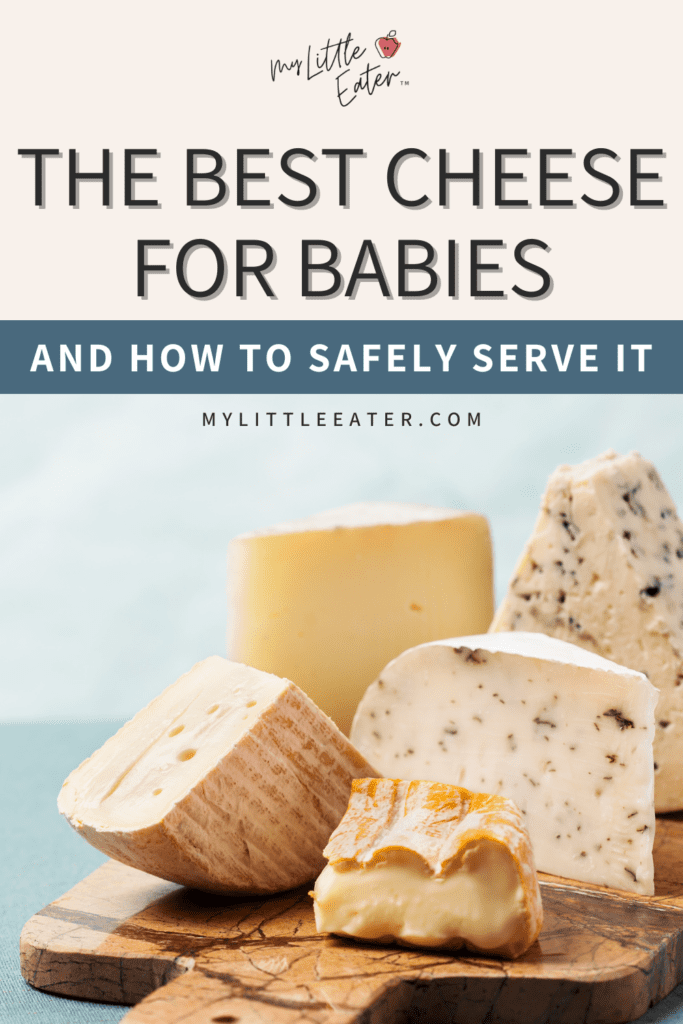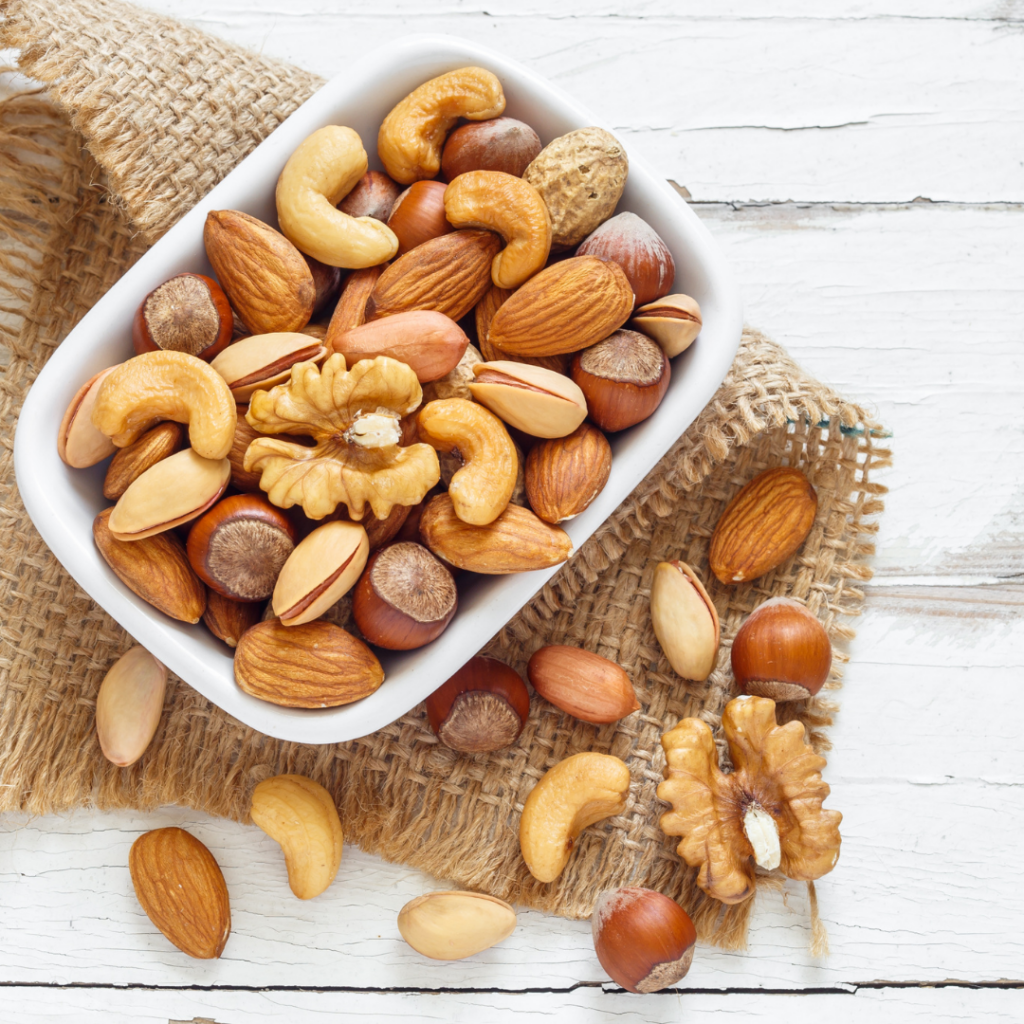Cheese makes the perfect snack, whether it’s for you or your little one! It’s yummy, nutrient-dense enough to fill you up for a little while, and there’s no preparation involved besides cutting it into slices – perfect right?
Well, almost. There are a few things to consider before offering cheese to your baby. Key characteristics to keep in mind are the salt content of cheese, whether it has been pasteurized, and the ingredients used in the cheese-making process.
Let’s go through everything you need to know about cheese for babies (and toddlers).
As a bonus, we’ve included the easiest recipe for making the best cheese for your baby – Labneh!
Be sure to check out our 60 Day Baby Led Feeding Meal Plan for over 60 recipes that are safe for your baby starting solids, including some that are perfect for introducing cheese with!
Table of Contents
When to introduce cheese to babies
You can serve your baby cheese around 6 months of age, just like most other solid foods. As long as your baby is showing all the signs of readiness, indicating they’re developmentally ready to handle solids, and as long as cheese is served safely.
Read more about the developmental signs of readiness so you recognize when your baby can start solids.

There’s no specific age for introducing one type of cheese over another. Ideally, avoid introducing your baby to cheeses with higher sodium content (more than 100 mg per serving) until after 12 months of age.
Even after 12 months, we still recommend limiting these higher sodium cheeses, despite the benefits of expanding your child’s palate with the various flavors and textures.
Some examples of these cheeses are American cheese and parmesan cheese. If you’re offering something that typically would have parmesan cheese sprinkled on top, nutritional yeast is a great substitute. While not actually cheese, it does provide that cheesy flavor and is safe for babies and toddlers.
We’ll go over sodium content in more detail later on.
Why can babies have cheese and not milk?
You’ve likely heard about the recommendation to avoid introducing milk or milk alternatives to your baby before their first birthday. To be clear, this recommendation is solely for milk or milk alternatives as a beverage.
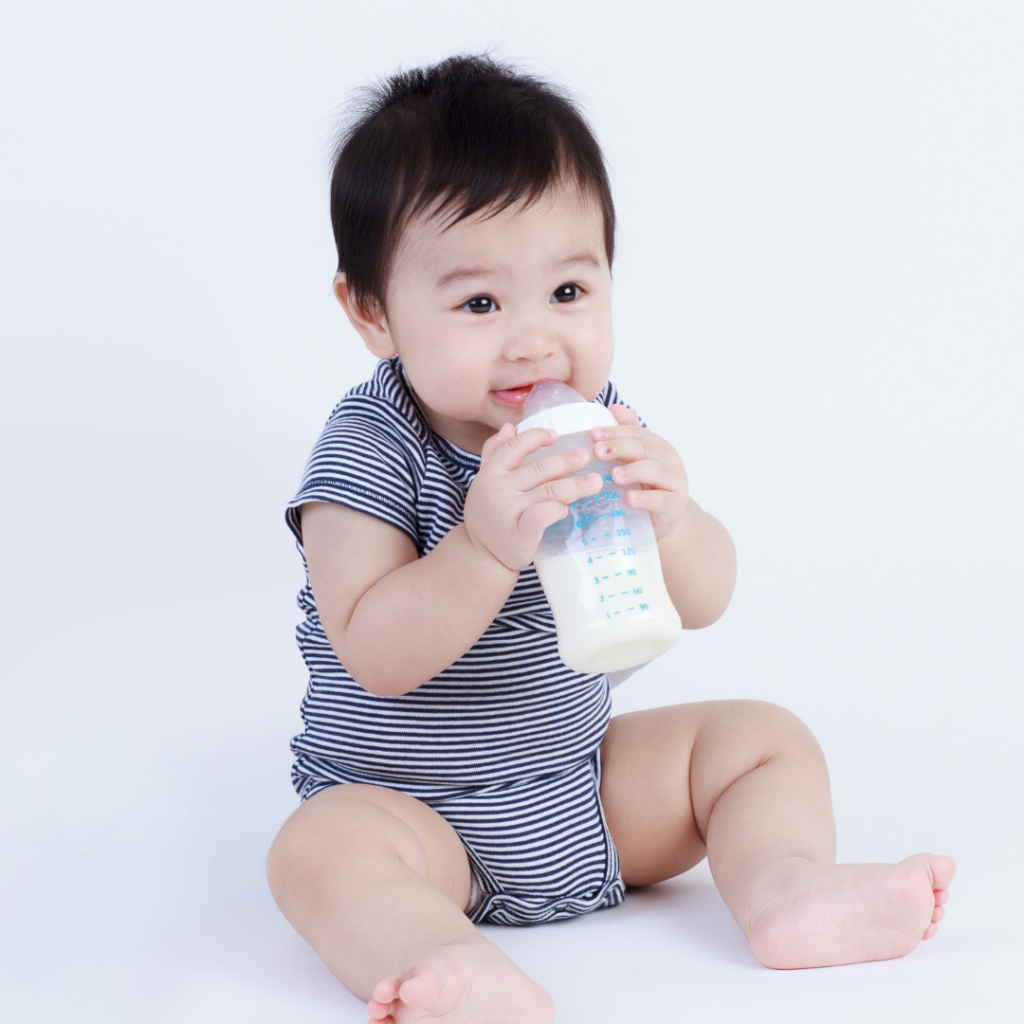
Using milk and other dairy products in recipes – or simply serving yogurt or cheese – is perfectly fine for babies! The reason we want to avoid milk as a beverage is because it can easily displace breastmilk or formula – which we don’t want to do!
Remember, babies are getting the majority of their nutrition from breastmilk or formula until about 12 months old. We don’t want them to miss out on those crucial nutrients because they’re too full from drinking cow’s milk or a milk alternative to nurse or drink their bottle.
Is cheese a top allergen?
Yes. Milk and dairy products are considered one of the top 10 allergens recognized in Canada and the United States.
Since cheese is an allergenic food, it’s recommended you introduce it to your baby as early as possible after starting solids and keep offering it to your baby often (1,2).
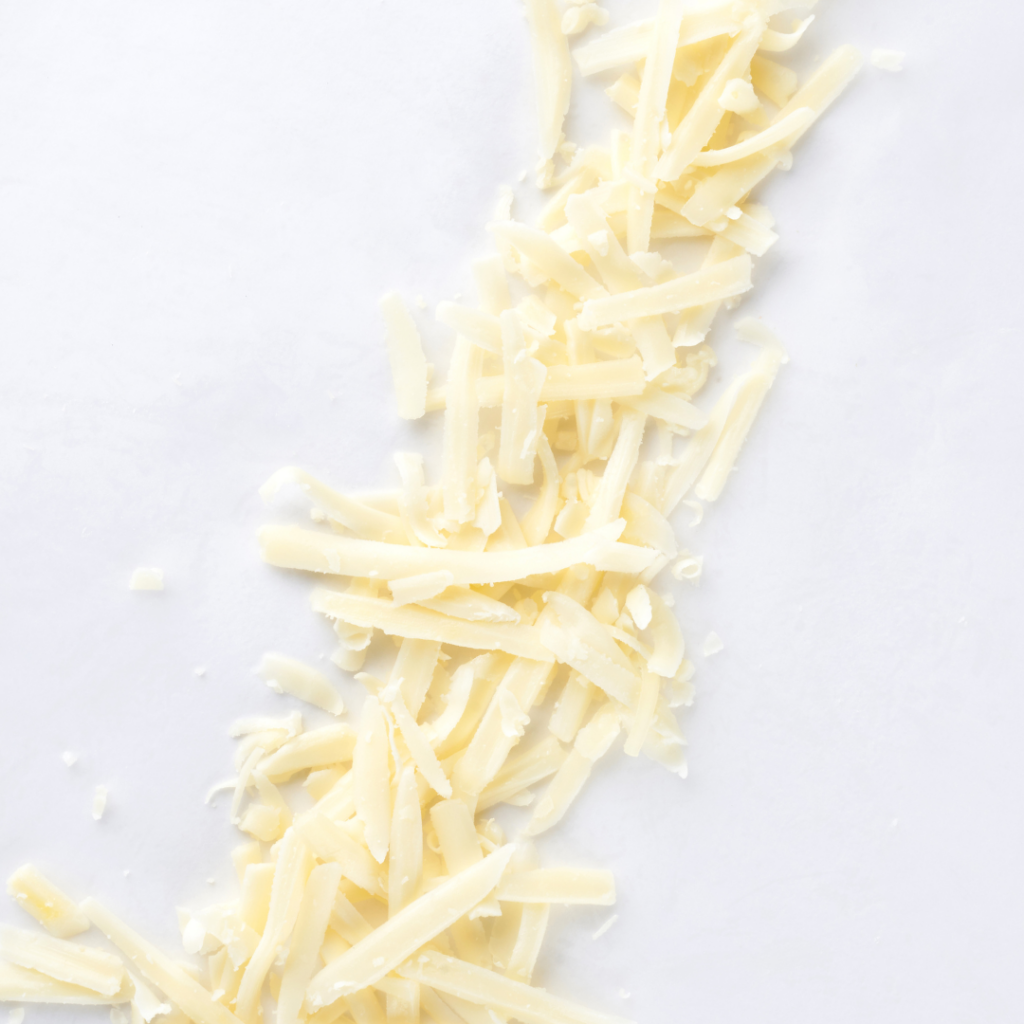
If your child is considered to be at high risk for food allergies, there may be a benefit to introducing allergenic foods earlier, between 4-6 months of age (1,2).
High risk is defined as someone who has an immediate relative with a food allergy, or they have other allergenic conditions or another known food allergy themselves.
This is best discussed with your baby’s doctor or allergist before you begin.
Here is the general protocol for introducing the top allergens. For additional details check out our blog on introducing highly allergenic foods.
- Stay home and offer them in the first half of the day when your baby is healthy.
- Offer the allergenic food in tiny amounts in the beginning, and increase the quantity over a few days. We recommend serving a very small amount and waiting 10 minutes for a reaction on the first introduction. If no reaction occurs, you can continue offering the rest of the food until they finish their meal. Continue to monitor for symptoms after that as they can be dose dependant. Re-introduce the following day in a larger quantity, if no reaction occurs.
- Space out the introduction of foods – introduce only one allergenic food per day and wait 1-2 days before introducing a new allergenic food.
- Record symptoms – if your baby is allergic to a food, you’ll typically see a reaction within 10-15 minutes after eating the food. There could also be a delayed reaction, so monitor baby for up to 6 hours after introducing the allergenic food.
- Offer the allergen regularly, as long as baby had no reaction during the first two times.
Did you know?
Did you know?
Goat cheese may cause a similar reaction to cheese created from cow’s milk. Therefore, if your little one has a cow’s milk protein allergy, it’s recommended that you do not offer goat cheese either.
If you’re feeling nervous about introducing allergens to your baby, and want someone to help guide you to ensure you get them all introduced in a timely manner – check out the 60 Day Baby Led Feeding Meal Plan!
It strategically introduces each allergen, taking into account the need to expose your baby to the allergen twice. And it provides recipes that account for where you are with allergen introduction and texture progression, so you never have to second guess if what you’re serving is safe for your baby.
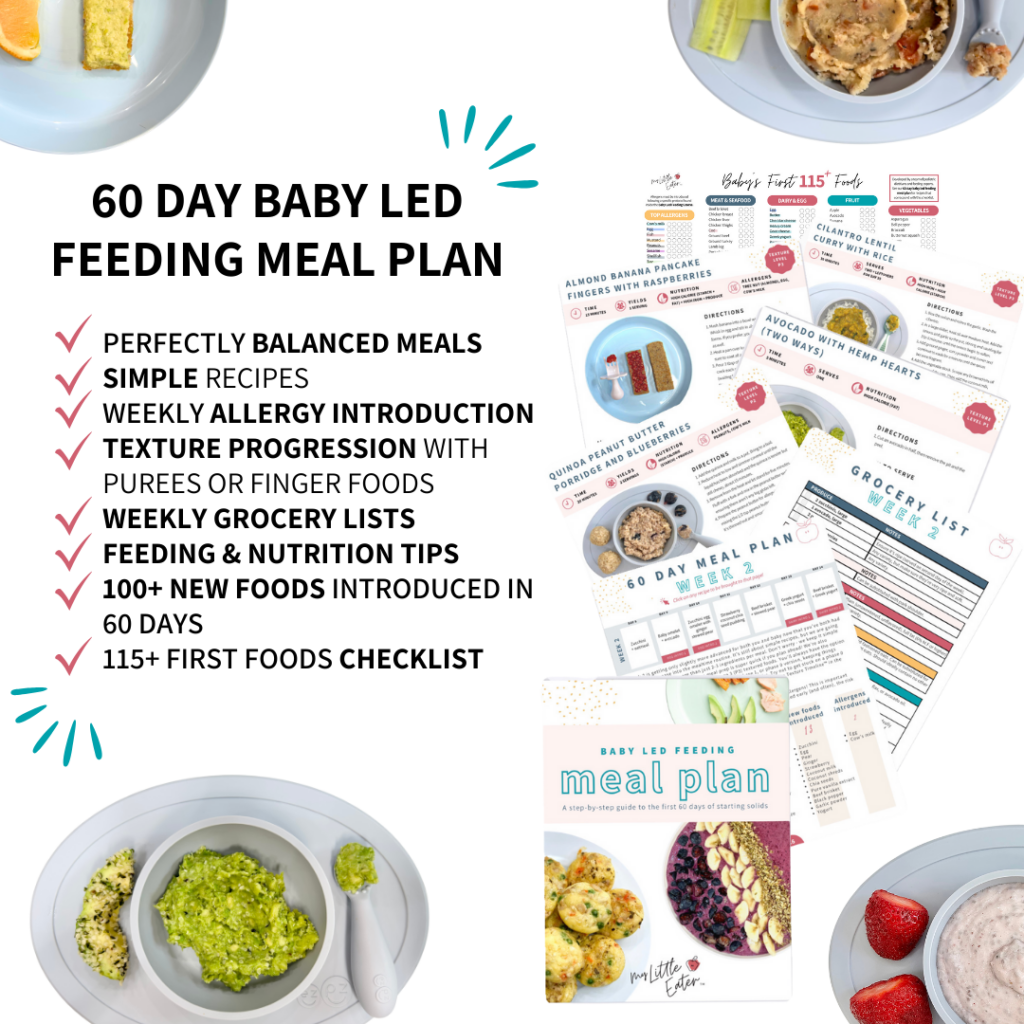
Lactose intolerance
Lactose is the primary carbohydrate found in milk. Lactose intolerance refers to the inability to digest lactose, and typically results in digestive symptoms such as stomach upset, gas, and diarrhea (3).
This is sometimes mistaken for an allergic reaction to cow’s milk protein, and while some allergic reactions may have similar digestive symptoms, such as vomiting or diarrhea, lactose intolerance is not an allergy (3). People with a sensitivity to lactose but no allergy to cow’s milk protein are still able to tolerate dairy products that are lactose-free (4).
Lactose intolerance is usually dose dependent and each individual can handle a specific amount of lactose before experiencing symptoms (5). Some people can’t handle much if any at all, and others are ok to consume some but can’t consume it in excess.
Most lactose is actually lost during the cheese-making process, which means most cheese is basically lactose-free (6). This is more common for semi-hard and hard cheeses because the lactose left over after processing is converted to lactic acid during the ripening process (6).
Therefore, depending on your child’s sensitivity to lactose, you may be able to offer it without negative consequences, even if you don’t purchase specifically “lactose-free” varieties (2).
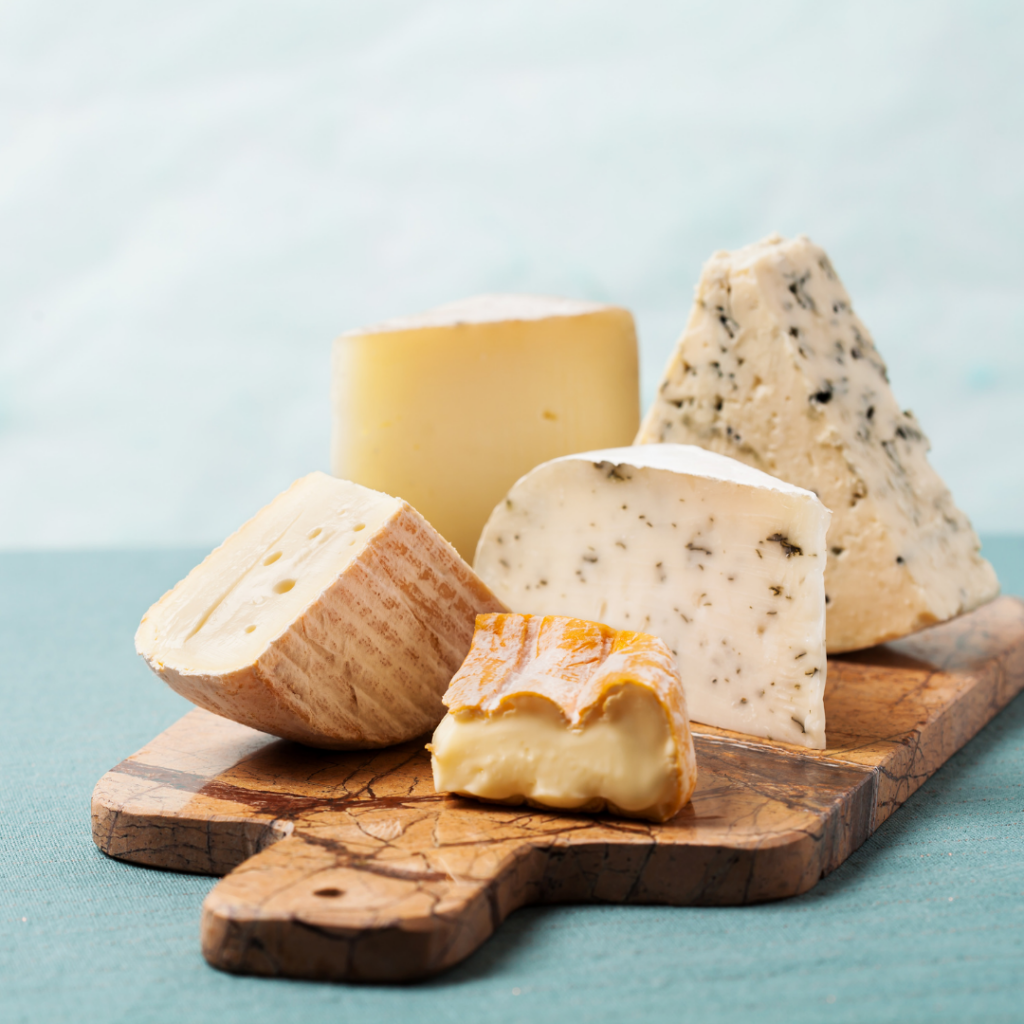
Lactose intolerance typically doesn’t occur in younger children but is quite common for older-aged children (7). If your little one follows a lactose-free diet as a treatment of lactose intolerance, you’ll want to know that most lactose-free products have the same amount of calcium as regular milk products (8). So, you don’t have to stress about whether or not your little one is getting enough calcium in their lactose-free diet.
What to consider when choosing cheese for your baby
Cheese can be a nutritious addition to your baby’s diet when consumed in moderation, as it’s energy-rich and high in fat, protein, vitamins, and minerals.
Some of the minerals that cheese can provide are calcium (builds strong bones and teeth), phosphorus (needed for the normal growth and development of bones), and magnesium (for overall health and optimal growth). All of these are very important building blocks during early development (9).
Additional key nutrients found in most cheeses include vitamin A, riboflavin, vitamin B12, and folate.
When you consider the criteria for choosing healthy cheese for babies, keep in mind the salt content and nutritional composition (ideally babies have cheese made with whole milk), and be sure that it’s been pasteurized.
Let’s go over some more specific details of what to look for.
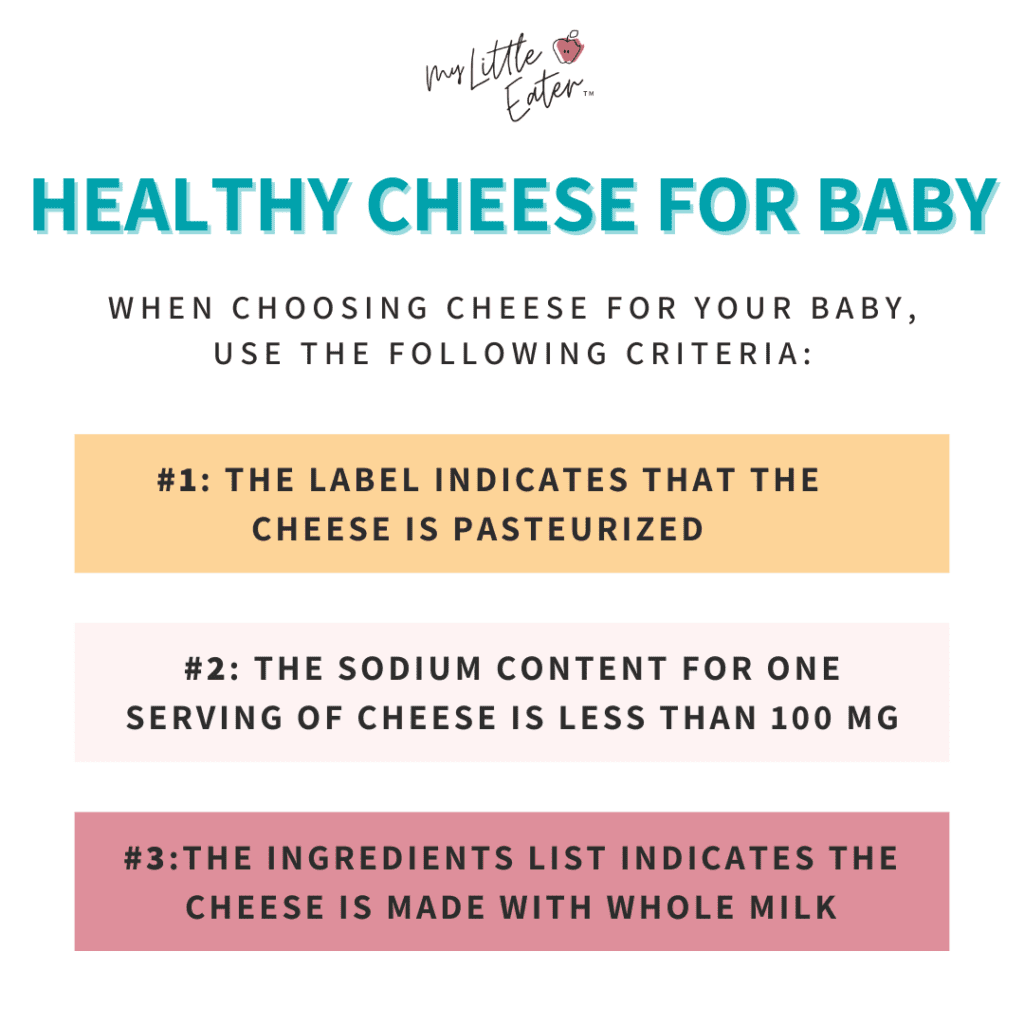
Processed vs. unprocessed
While most cheese can be a healthy addition to your baby’s diet, it’s important to note that not all cheeses are equally nutritious. When you’re shopping for the best cheese for your baby, processed cheeses should be avoided.
Many of them contain extremely high amounts of salt (2 to 3 times the amount in real cheese) and a number of added ingredients, such as preservatives, that aren’t recommended for your baby.
Processed cheeses have a much longer shelf life than real cheese, due to the high amounts of salt and other preservatives added to the products. They’re identifiable in grocery stores as they’re typically shelf-stable and found outside of the refrigerated section. One exception is processed cheese slices, which are kept refrigerated.
You’ll find real cheese in the refrigerated section, typically with other dairy products like yogurts and butter.
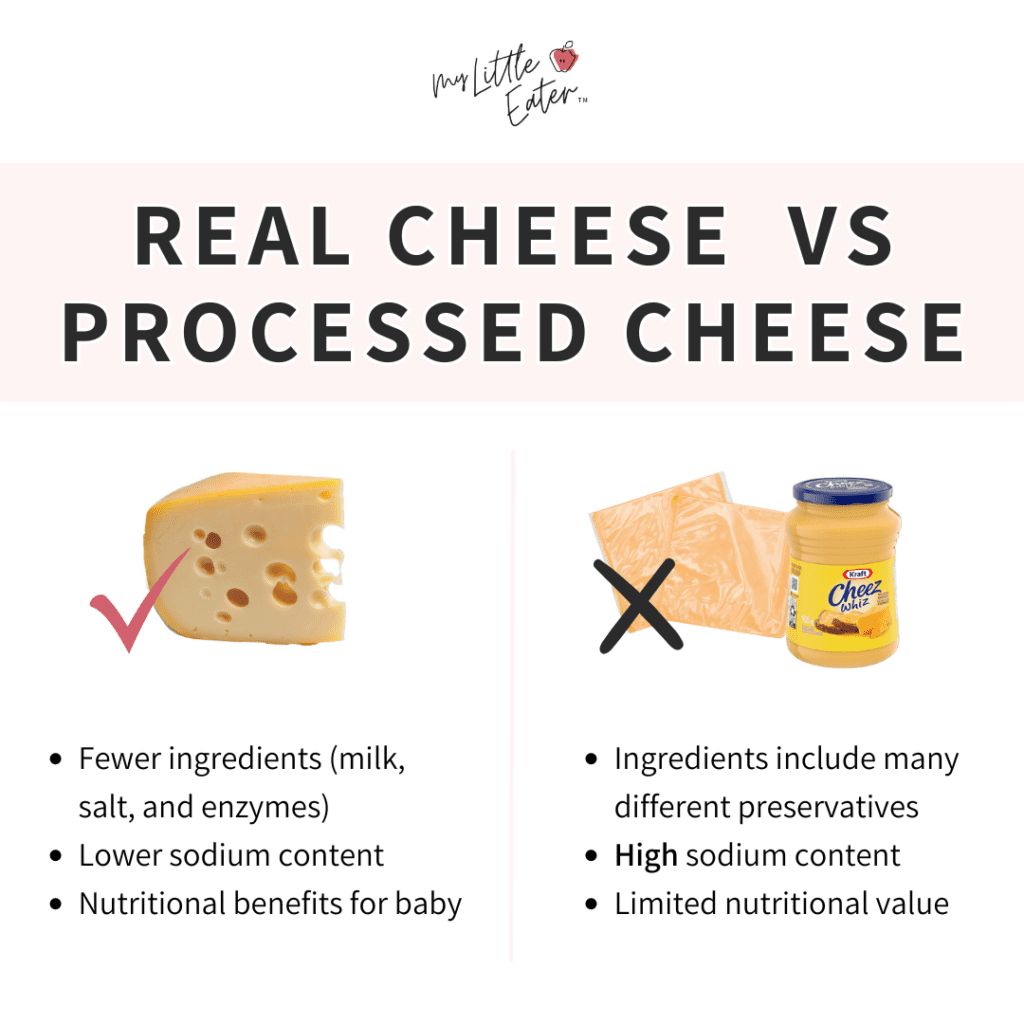
Common types of processed cheeses that are NOT recommended for babies include:
- Jar cheese (Cheez Whiz)
- Cheese and cracker snack packs for children
- Cheese in squeeze bottles or cans
- Cheese slices individually wrapped in plastic
You want to offer your baby cheese that is minimally processed and nutritionally dense – like labneh, for example.
Labneh is one of the best cheeses for your baby as it’s rich in protein and fat, all while having low sodium content. Another benefit of labneh is the fact that it’s a soft cheese spread, which makes it super easy to incorporate into your baby’s diet as soon as they start solids. Be sure to check out the recipe at the end!
Organic vs. non-organic
Both organic and non-organic (conventional) cheese and dairy will provide your baby with all the same beneficial nutrients.

The research comparing organic and conventionally (non-organic) produced milk is complicated as many factors influence the nutritional outcome of milk, such as the cow’s diet and the breed of the cow (among others) (10). These are hard to control for because even with a category such as “organic” or “conventional”, different diets and breeds of cows are used on different farms and in different countries (10).
What we do know is that organic milk in the US ensures cows haven’t been treated with any antibiotics. And cows from low-input farms (which are typically associated with organic farming, but can be used on non-organic farms as well) produce higher levels of omega-3 fatty acids and CLA – a healthy fat for the brain. This is also seen on farms that feed their cows a high-forage diet. This is more commonly associated with organic dairy cows but can be seen in conventionally raised cows as well (11).
If possible, it’s best to talk to your local farmer, or seek out more information about the farming practices where your milk is purchased from, if these factors are important to you.
Pasteurized vs. unpasteurized
You should only offer your baby pasteurized cheese to avoid the risk of them coming in contact with harmful bacteria that are sometimes found in unpasteurized cheese.
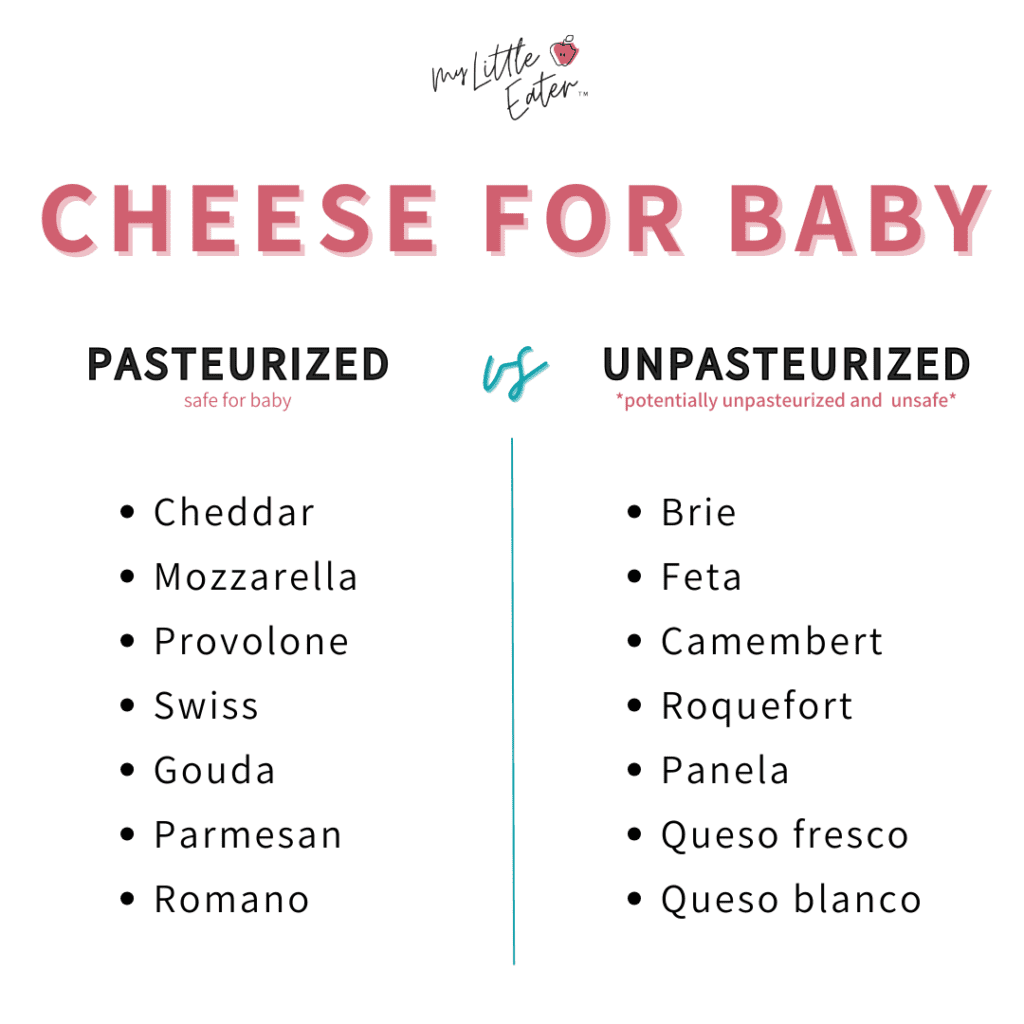
Pasteurization refers to the heating process of raw milk to a temperature of 161°F for more than 15 seconds. This kills any bad bacteria and makes the cheese safe to consume.
All cheeses sold in major grocery stores in the United States and Canada should be pasteurized, but always check the labels or ask if it’s not clear. If you are at a local farmer’s market, or a roadside produce stand, there is no guarantee that the cheese you’re buying has been pasteurized, so take extra caution or avoid it if you’re unsure.
There is one cheese that is an exception to this rule and that’s Parmigiano Reggiano. This is a type of unpasteurized cheese that can be sold in stores (in Canada and potentially other countries). However, in Canada, it must undergo an aging process that helps reduce the risk of food-borne illness for a minimum of 10 months (12).
Some people believe that high temperatures associated with pasteurization destroy important nutrients in raw cheeses. This is why you may see opposing recommendations for what is best for your baby. However, numerous scientific studies have demonstrated that pasteurized cheeses have the same quality of nutrients when compared to unpasteurized cheeses (13,14).
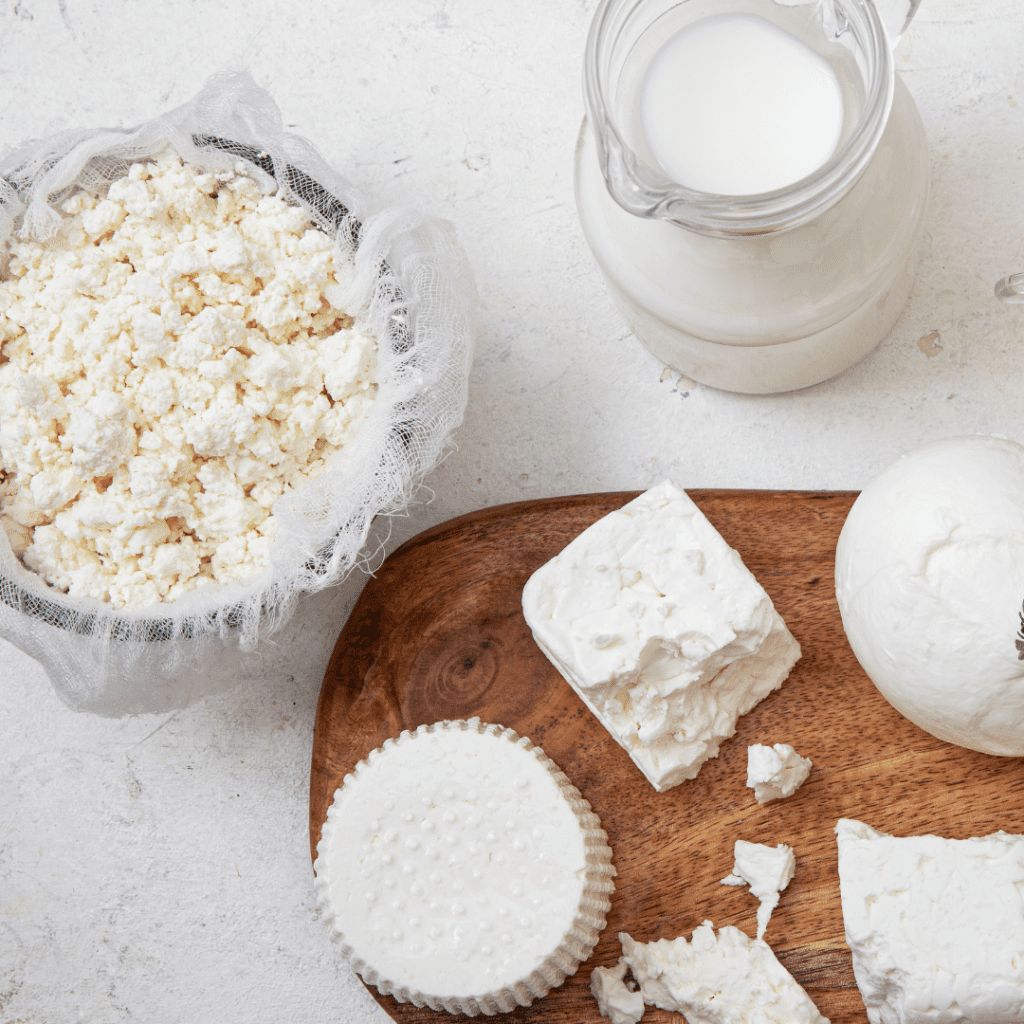
Research has shown that there is a higher risk of complications involved with infections from consuming unpasteurized cheese, particularly for pregnant women and young children (13). However, researchers agree that more studies are needed to accurately determine how risky it really is for this population (13).
Therefore, the recommendation is to wait until 5 years old to offer unpasteurized options. You can try offering them at 1-2 years old for the benefit of exposing your little one to new textures and flavors, if you feel comfortable with the risk.
Full-fat vs. low-fat
Your baby needs full-fat cheese as it will provide essential nutrients for early development.
Fat plays an important role for babies and toddlers as it will help them reach their maximum growth potential and it supplies a major source of energy for babies. It also promotes the accumulation of stored fat in the body which works as insulation to reduce body heat loss, and as padding to protect body organs (13).
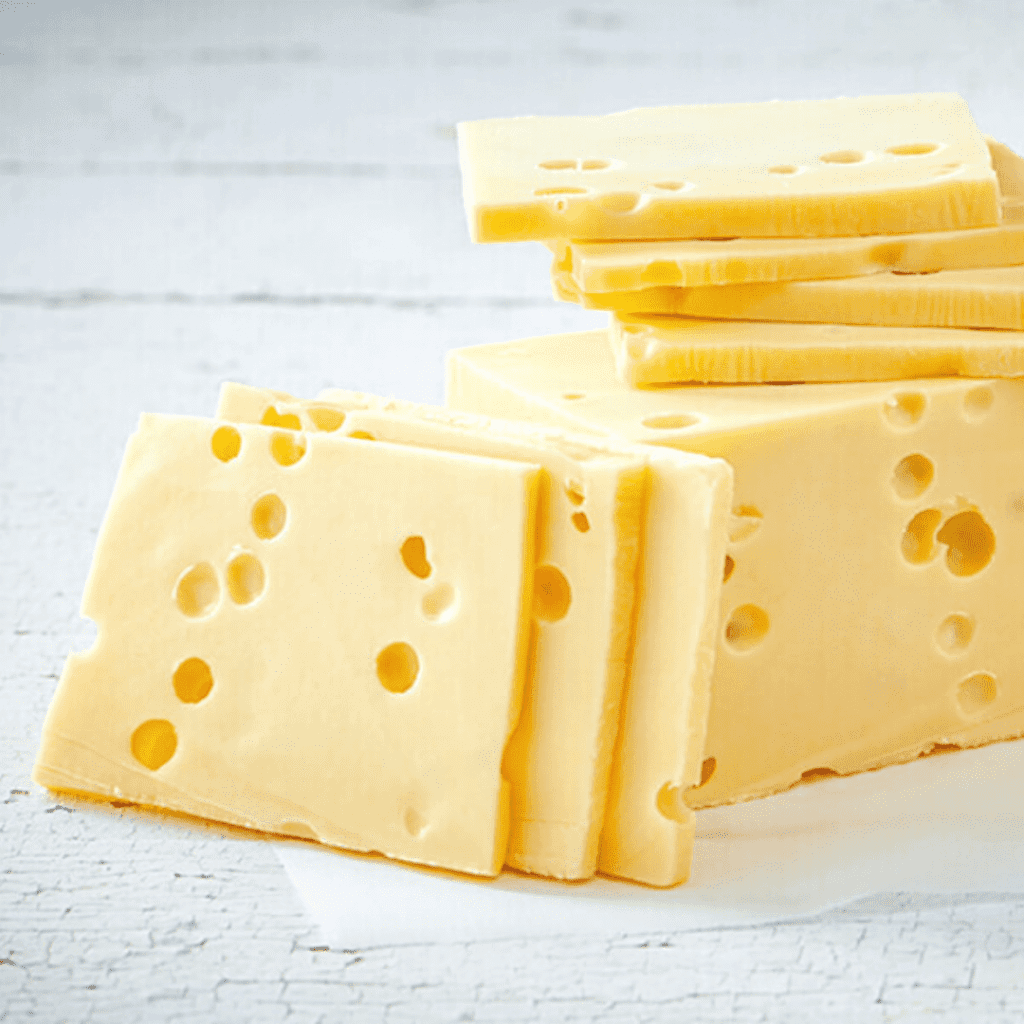
Fat is also needed for the absorption of the fat-soluble vitamins like A, D, E, and K (13). Fat also provides essential fatty acids that are required for normal brain development, healthy skin and hair, and normal eye development (13).
By choosing low-fat cheese, or other low-fat dairy products, your baby may be missing out on all the benefits from full-fat dairy products.
Sodium levels
As we briefly mentioned above, sodium levels are something you will want to pay attention to when offering your baby cheese. We’ve seen the recommendation to avoid cheese altogether for babies many times because of concerns over salt content.
However, not all cheese has a high sodium content. It can absolutely be part of a balanced diet for babies because there’s so much variety when it comes to cheese!
Some cheeses can be very high in salt, while others contain small amounts. This is because salt is used as a preservative during the cheese-making process, so different cheeses contain varying amounts of salt.
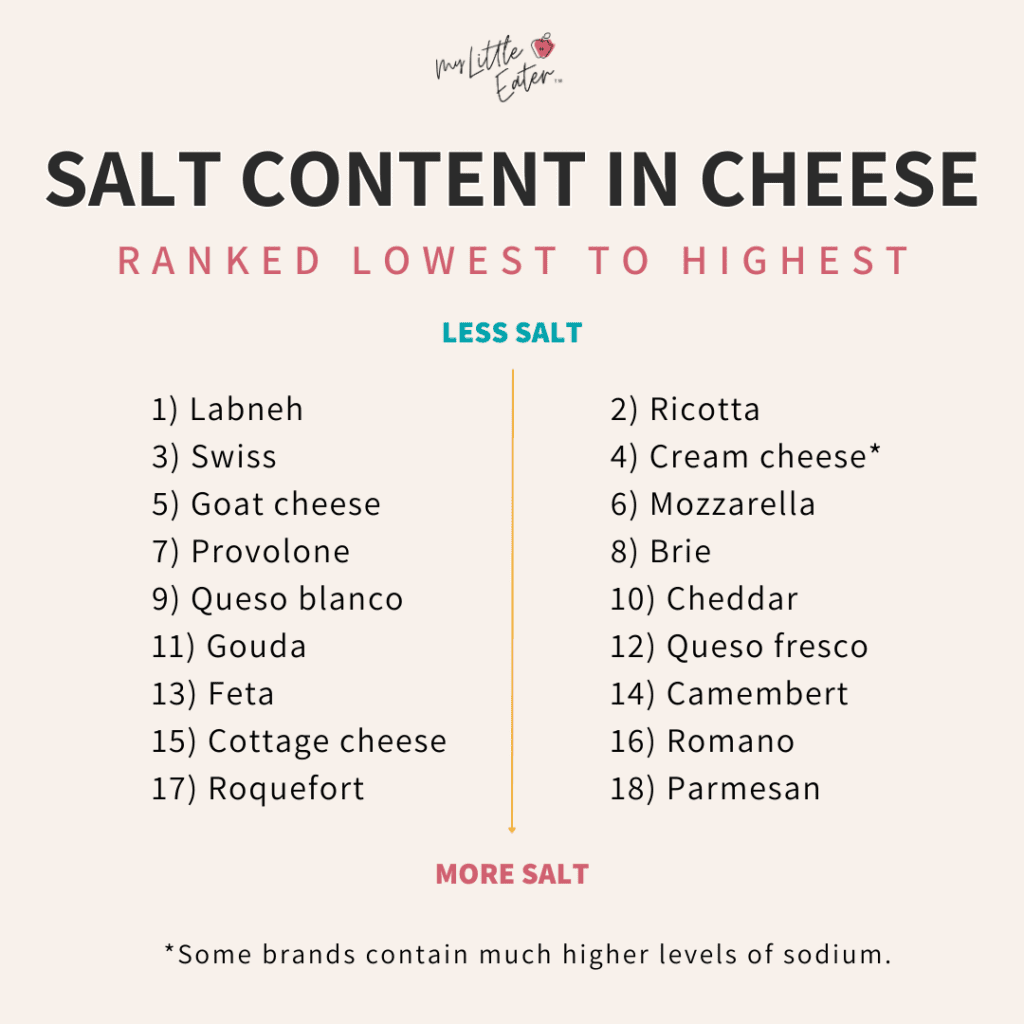
Plus, cheese will expose your baby to new textures and flavors. Therefore, we recommend introducing lower sodium cheeses to your baby early on in your baby led feeding journey.
Pro Tip!
Pro Tip!
Cottage cheese is a great texture for babies and it can be offered on a spoon or spread on toast for a finger food option.
But – it is higher in sodium! Try mixing it with yogurt or low-sodium ricotta to balance out the salt when serving it to your baby.
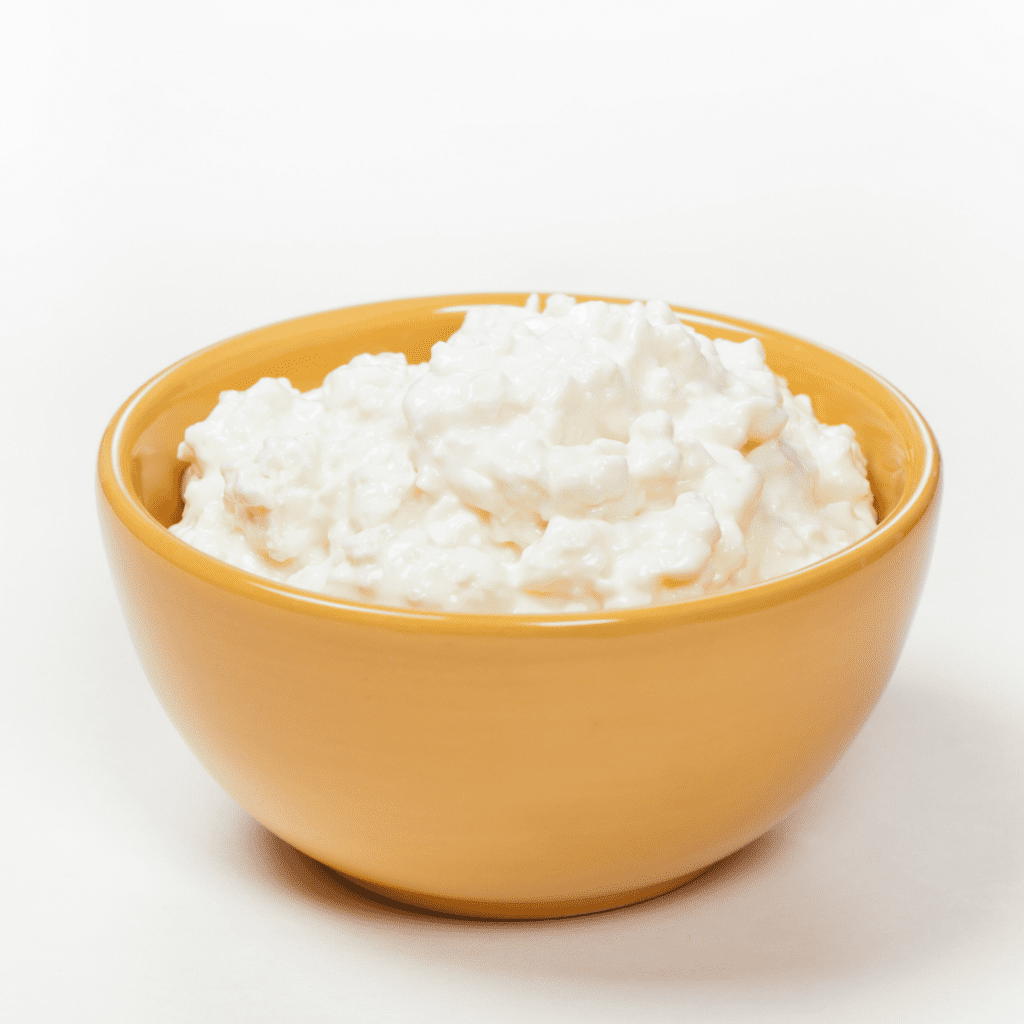
If you want to know more about salt recommendations for babies (and how you don’t have to freak out about it as much as we’re sometimes made to think we should), check out our blog – The Truth About Salt For Babies!
Calcium content (after 12 months of age)
Dairy products, like cheese, are naturally rich in calcium, but calcium levels do vary depending on the type of cheese.
As you begin your baby led feeding journey, around 6 months of age, your little one will be getting the majority of their nutrients, including calcium, from either formula milk and/or human breast milk. The calcium from breast milk is more completely absorbed than the calcium from cow’s-milk-based or soy-based infant formulas. However, higher levels are present in infant formulas to account for the difference in absorption (15).
So, while your baby is getting most of their nutrients from milk, choosing a type of cheese to serve based on the highest levels of calcium isn’t really necessary.
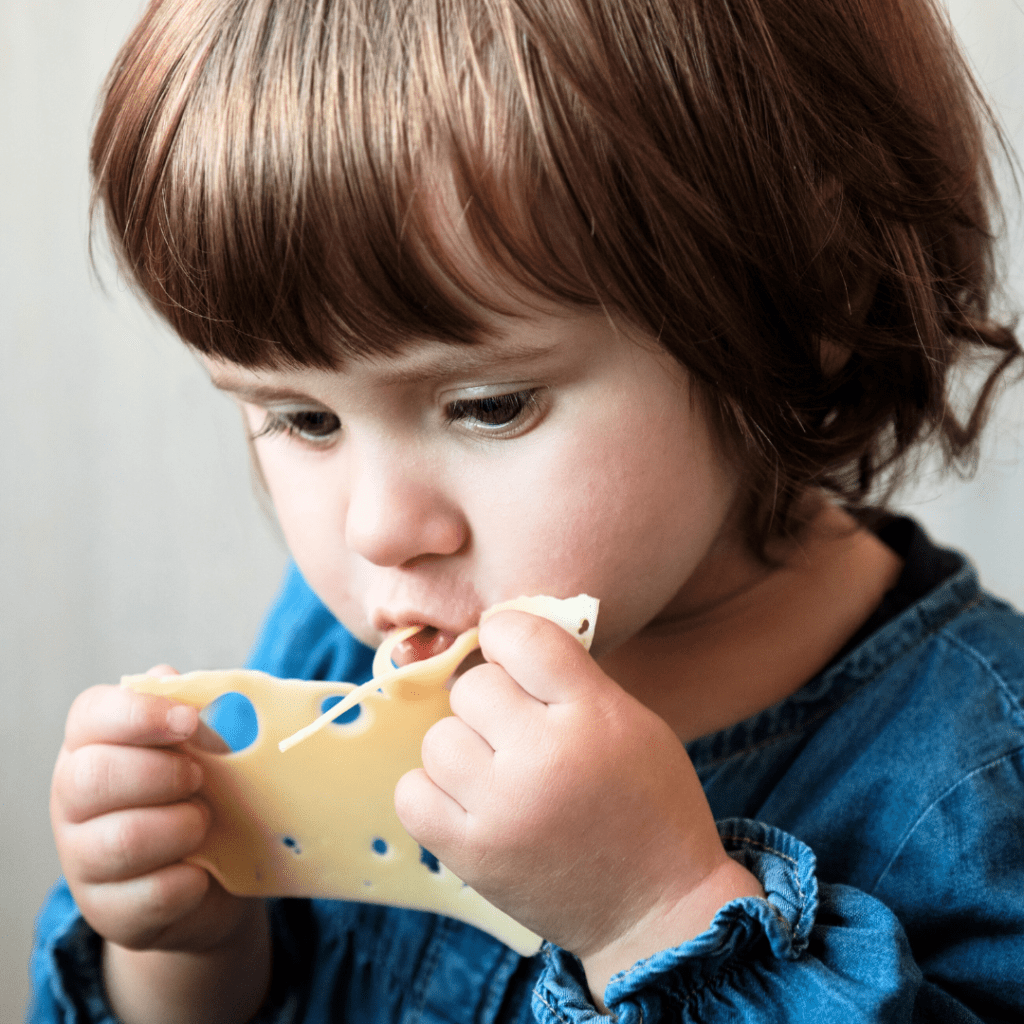
Around 12 months of age, and throughout toddlerhood, when milk consumption typically begins to decrease, your toddler’s calcium needs will increase. Changing from 270 mg a day for babies 7 to 12 months, to 700 mg a day for toddlers 1 to 3 years of age (15).
Choosing a type of cheese that’s higher in calcium (while still lower in salt) can be beneficial to help your little one achieve their daily dose of calcium, which helps them build strong bones. Cheddar cheese and mozzarella are both good sources of calcium for your toddler. Just remember to still keep an eye on the salt content after 12 months of age.
Labneh, our top cheese choice for babies, is made with yogurt. So, the calcium content of the labneh you prepare will depend on the type of yogurt you choose. Yogurt is generally an excellent source of calcium, but it will vary a little depending on the brand.
Although the amount of calcium varies, labneh is still a great calcium-wise cheese option – not only for babies but for toddlers too!
The best cheese for babies
Now that you know the nutritional considerations to keep in mind when choosing a cheese for your baby (or toddler), let’s get right to what our dietitian-recommended varieties are!
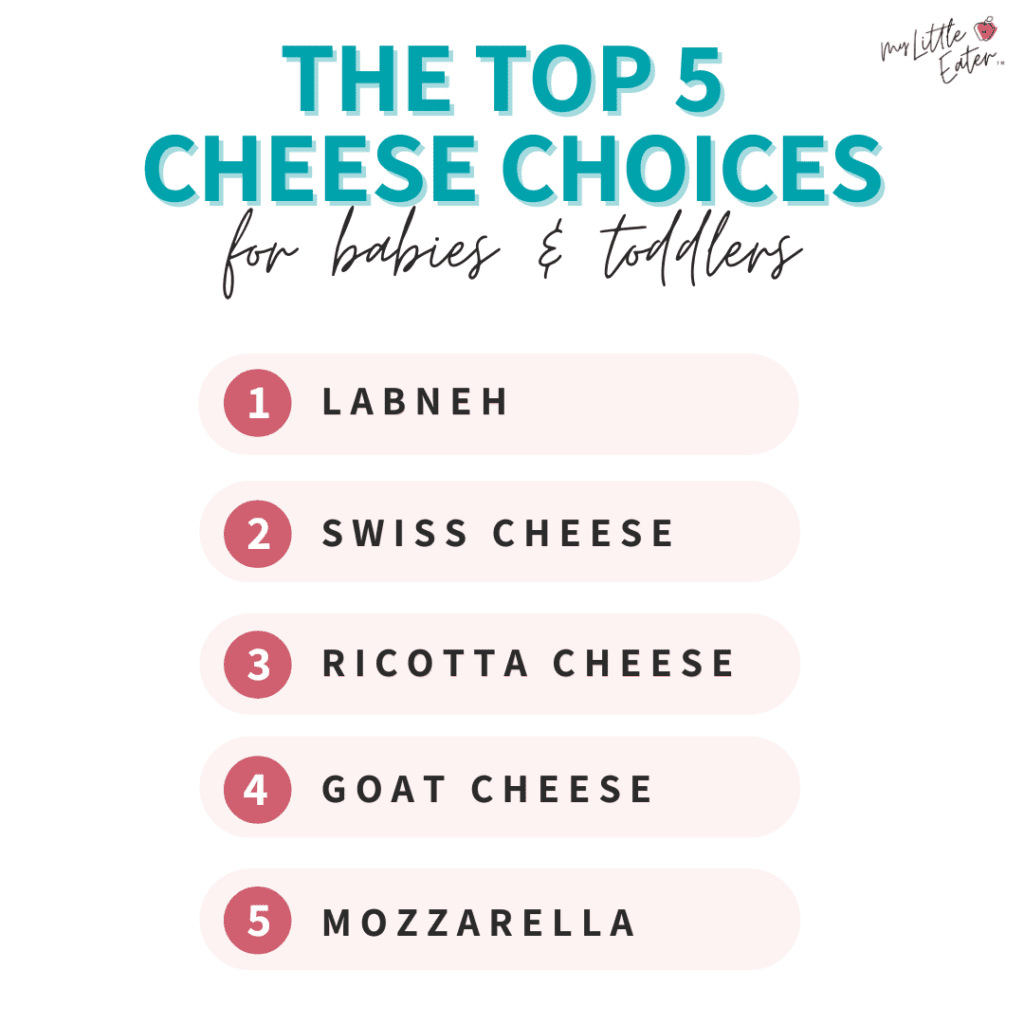
These top 5 cheeses are among the lowest in sodium, in comparison to most other cheeses. This means they’re safe for baby as soon as they’re ready to start solids. We’ve also considered fat content as a criterion for developing our recommendations because full-fat cheese will provide your baby with lots of different nutrients they need for optimal growth and development, as mentioned above.
Even though we recommend these as the top 5 cheese choices for your baby, always read the nutrition label carefully when shopping for cheese, as different brands can have varying amounts of salt. Remember that it’s best to choose cheese that provides less than 100 mg of salt per serving for babies under 12 months of age.
This is also true for fat content; inspect the labels carefully to make sure you don’t accidentally buy the low-fat version.
Pro Tip!
Pro Tip!
An example of why you should always read the nutrition labels carefully is with respect to cream cheese.
Certain brands have higher levels of sodium compared to others. We looked at a few options and wanted to note one brand in particular that we like and would recommend for babies – Tre Stelle’s organic cream cheese spread.
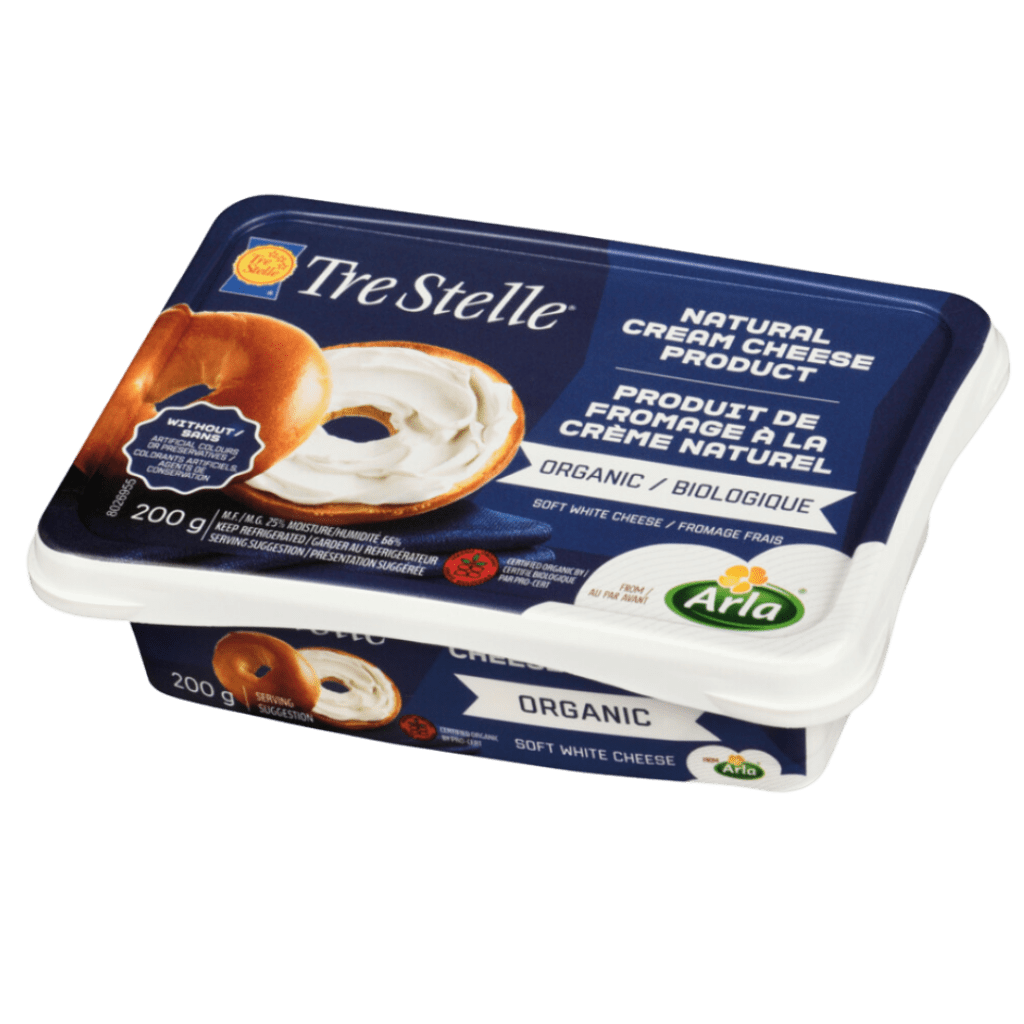
This has only 60 mg of salt per serving (1 oz or 30 grams), so if you like cream cheese and regularly buy it, this is a good option that your baby can enjoy too!
Is cheese a choking hazard?
Cheese can become a choking hazard when cut in specific shapes like small cubes, thick slices or when in a cylindrical shape (think cheese sticks or strings).
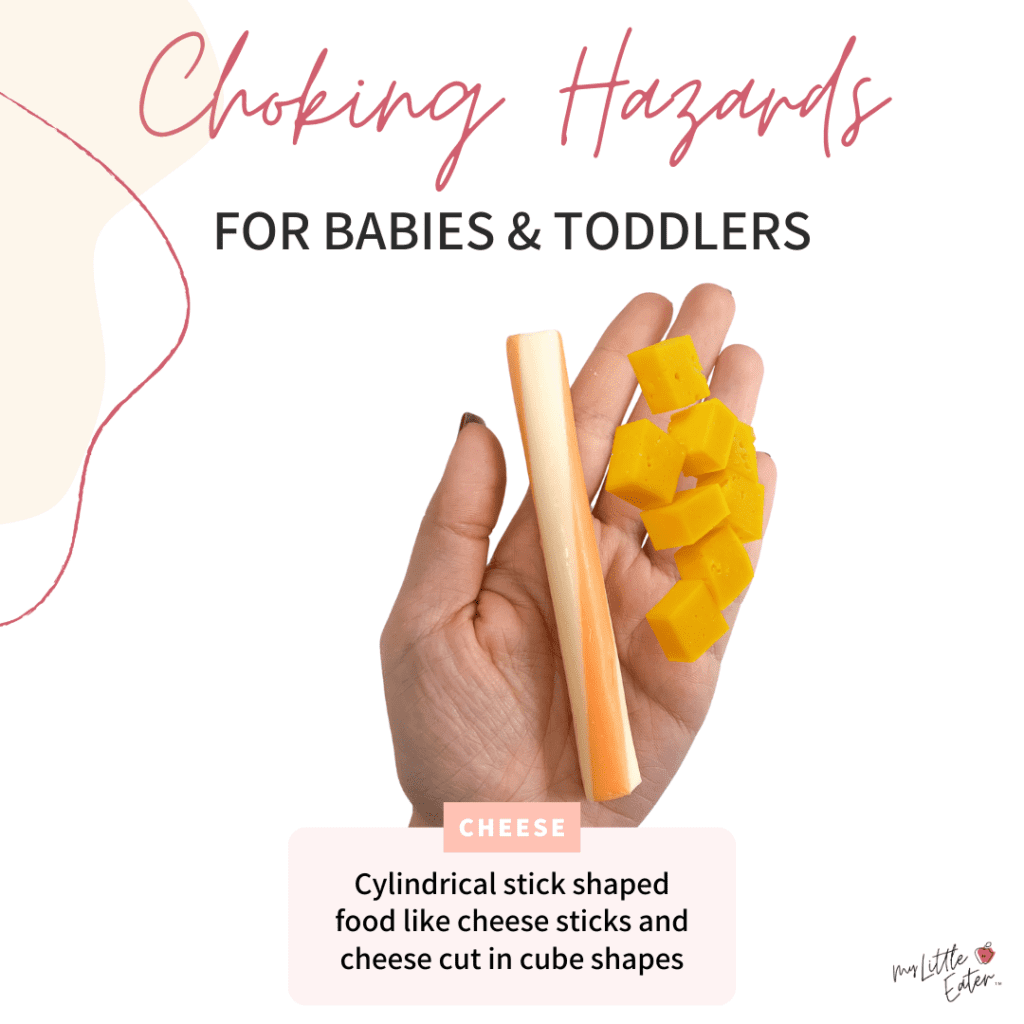
These shapes make it the perfect size to get lodged in your baby’s airway and won’t dissolve easily with saliva.
Thick melted cheese can also be a choking hazard, like cheese melted on garlic bread. The texture of the melted cheese can form large globs in the mouth that are tough to break down and can become stuck in your baby’s airway. Instead, offer thinly spread out layers of melted cheese for new eaters.
Eventually, you’ll be able to offer cheese cubes and thick melted cheese when your toddler has developed sufficient chewing skills. Oral motor skills develop at different rates for every child, so there’s no one age we can recommend to start serving your toddler cheese in these forms. It will depend on your child’s personal capabilities and you’re the best person to make that decision – you know your child best!
Be sure to listen to our podcast episode on when to stop modifying foods that are choking risks for further guidance.
How to safely serve cheese for baby led weaning
Remember that every baby is slightly different in terms of growth and development. Your little one may not be fully ready for solids by exactly 6 months of age, and that’s ok!
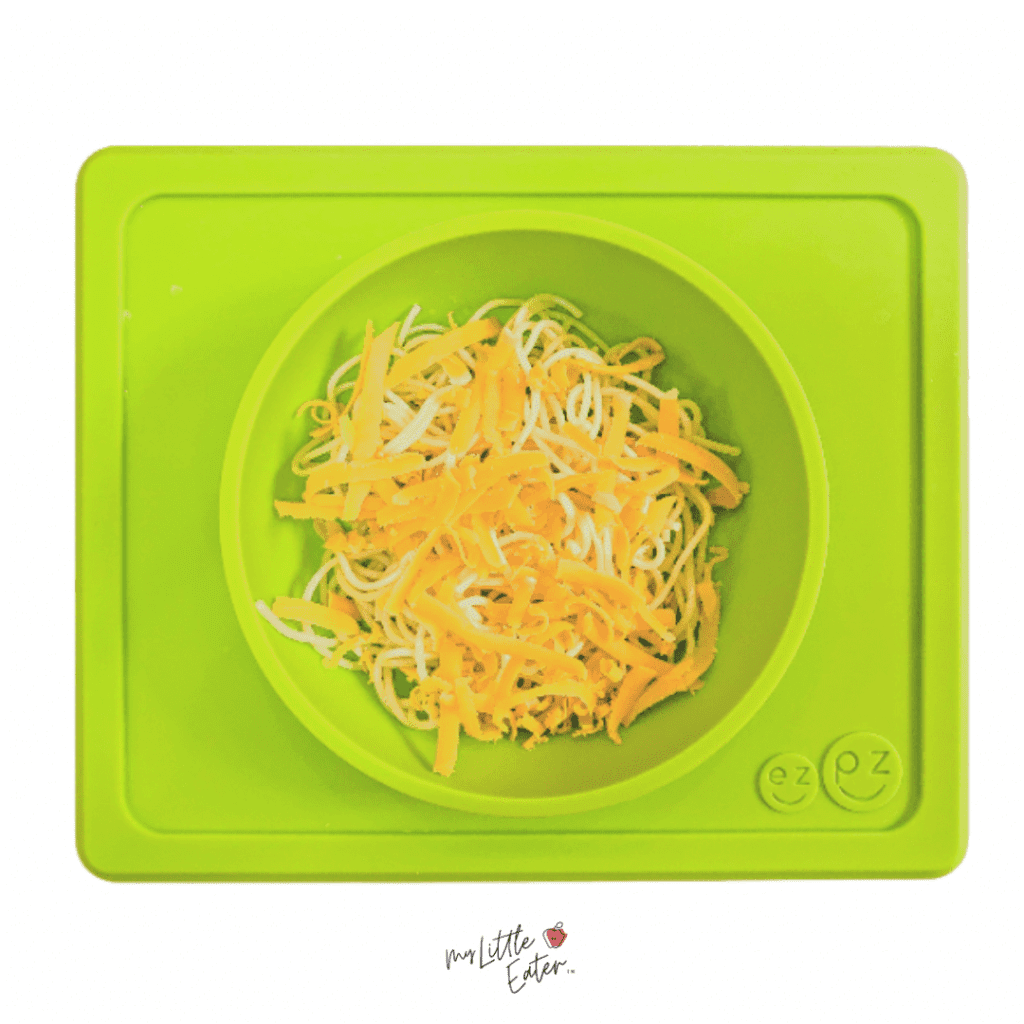
The same goes for toddlers. Eating skills will vary for each child, so it’s important for you to recognize your own child’s skill level and make the best decisions based on that.
Think of the ages we mention as a guide – but always consider your child and their development when assessing what would be safe for them.
Babies (6-12/18 months)
Once baby is ready to start solids, around 6 months of age, you can offer low sodium, pasteurized cheese in a number of different ways, including…
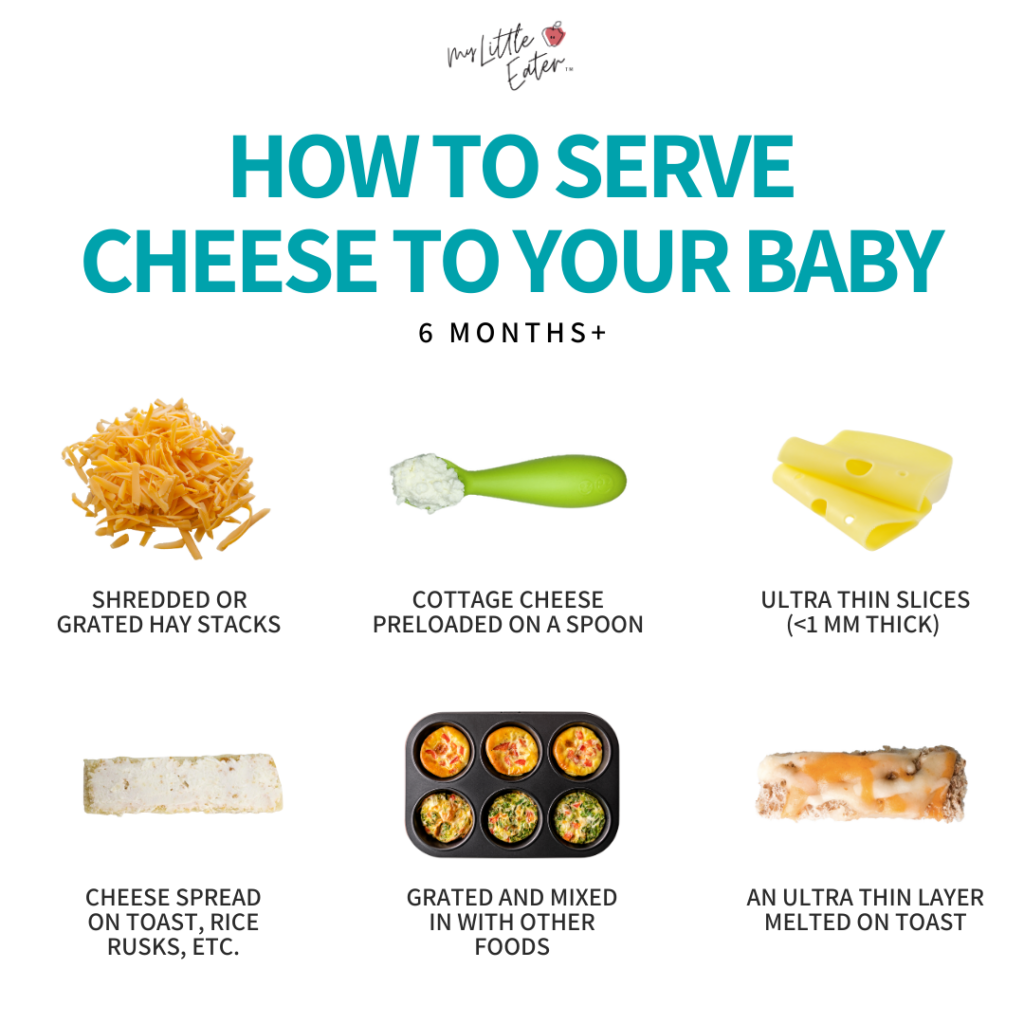
- Ultra thin slices (<1 mm thick) using the slicer side of a cheese grater. A very sharp knife or cheese slicer will also work. This will allow your baby to hold the cheese slice and self-feed.
- Grate or shred the cheese and pile it in a haystack so baby can pick it up easily with their palmar grasp, or they can use their pincer grasp with their thumb and forefinger (once that skill has been mastered).
- A cheese spread, like labneh for example, on a variety of foods like toast or rice rusks. You can also offer other soft cheeses by themselves or as spreads, like cottage cheese and ricotta. For more info, check out our toast topping blog for our top 10 healthy toast toppings for babies and toddlers!
- Grated or shredded cheese folded into other foods like mashed vegetables, pasta, eggs, grains, etc.
- Ultra-thin layer of melted cheese. A very small amount of grated cheese can be sprinkled on a variety of foods and melted. Remember that thick layers of melted cheese are a choking hazard for babies, as the cheese can turn into a large glob and potentially block your baby’s airway.
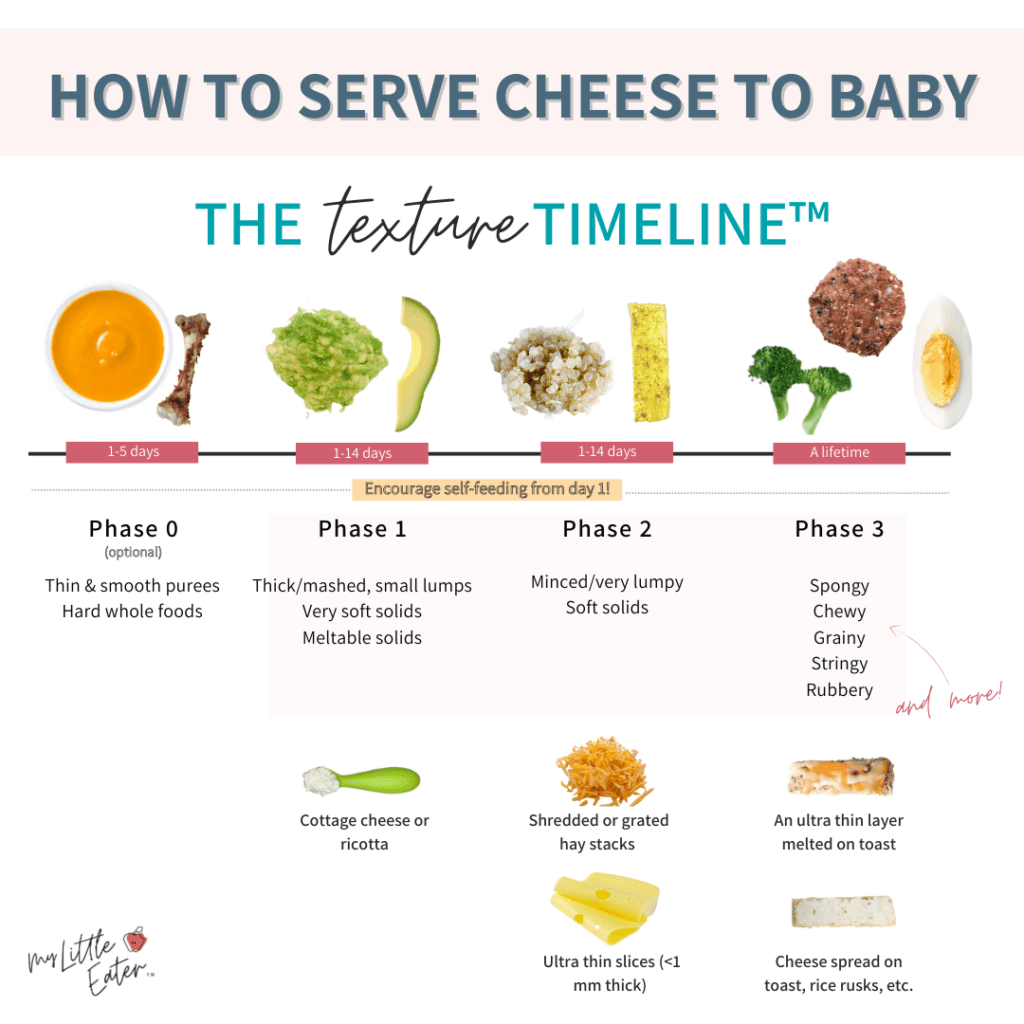
Toddlers (12/18 months+)
One of the most popular items given to toddlers as a quick snack is a pre-packaged cheese string. If you’re offering your toddler a cheese string, we recommend quartering it due to its rubbery texture and perfectly round shape that could lodge in your toddler’s airway.
To be clear, cheese strings should not be offered to babies as they’re a high choking risk, and typically high in sodium. It’s recommended to wait until your little one is at least 12 months of age before you offer a modified cheese string.
Some other ways to offer cheese as a calorie booster for toddlers is to melt it on toast, use cheese spread on things like crackers or naan bread, mix it into pasta or rice, or melt it on top of veggies.
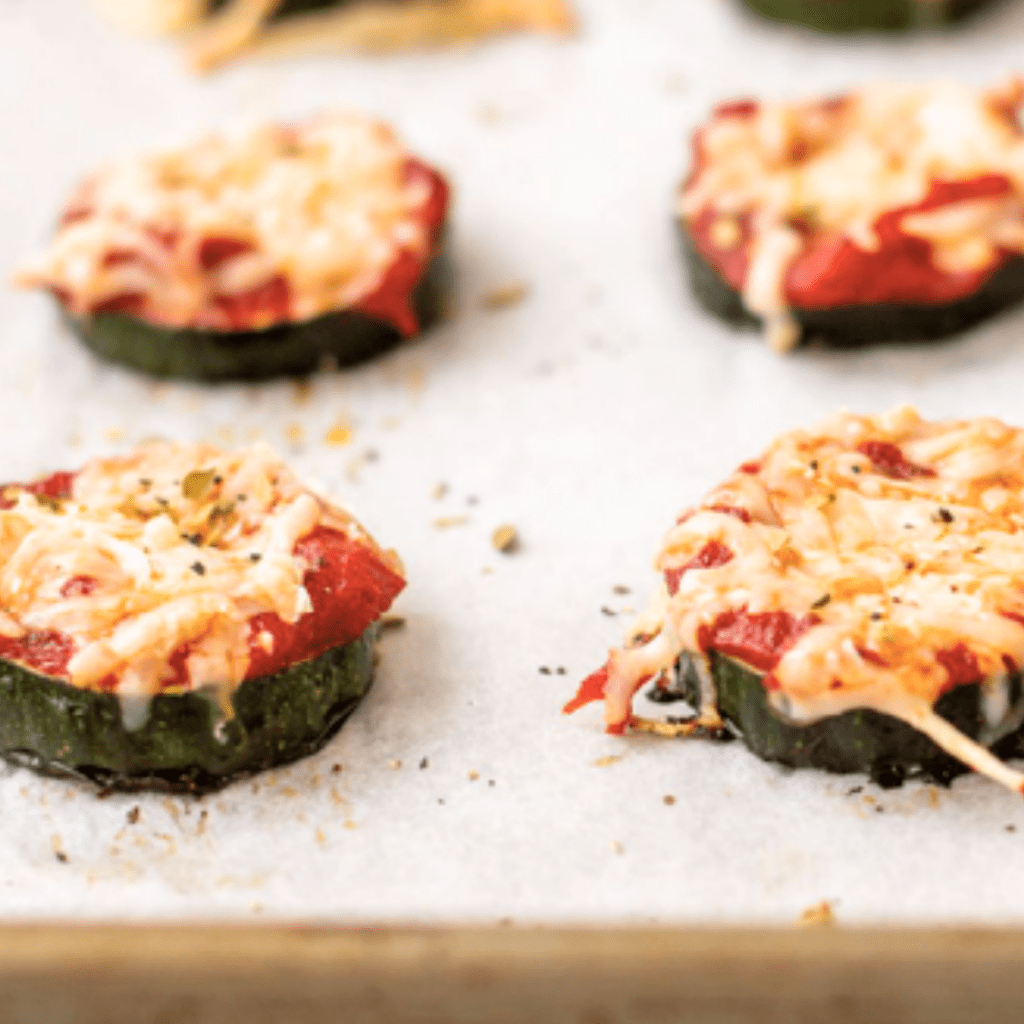
There are conflicting recommendations about offering toddlers cheese cubes. Basically, it comes down to your child’s eating skills. We personally prefer to offer shredded or thin strips of cheese as finger foods so they can take bites.
Most children can handle bite-sized pieces around 18 months of age, but it’s still a choking hazard since it could easily block their airway. By 2 years of age, you can teach them to take bites – then you can offer bite-sized cubes if you feel comfortable with that.
Cheese for babies: FAQs
Will cheese make my baby constipated?
If your baby is consuming significantly more than the recommended amount of cheese, which is about 1-2 oz of cheese per day, they could develop issues with hard stools and constipation. Cheese has a low amount of fiber and a high amount of fat, so too much cheese can cause issues with digestion.
It’s important to include foods with the right type of fiber and enough fluids in your baby’s diet to avoid issues with constipation and to promote healthy digestion.
If you want to learn more, check out our detailed blog on everything you need to know about your baby’s poop!
Can babies eat vegan cheese?
If your baby has an allergy or sensitivity to dairy products, you can offer them vegan cheese, if you wish. Doing so would be beneficial for flavor and texture exposure.
However, the nutritional aspect of vegan cheeses is significantly different from cow’s milk-based cheese. Vegan products, in particular, are made up of ingredients that consist of many preservatives and are typically higher in salt. You will have to read the label very carefully and determine whether or not the product is suitable for your baby.
Is there a concern about the color of cheddar cheese?
We know that many parents are concerned about the bright orange color of many cheddar cheeses, or cheese products, on the market.
We recommend paying close attention to labels and opting for cheddar cheese that does not contain synthetic or artificial dyes. Instead, we recommend choosing white cheddar cheese or orange cheddar that has been dyed using annatto (a seed from the achiote tree) as a more natural alternative.
How often can infants eat cheese?
Cheese and other dairy products are easy to overload on for babies and toddlers because they taste so good and it’s a familiar food for them. Although they’re getting good fats, protein, and important nutrients – it will leave no room for other important nutrients from other food groups.
That’s why offering cheese to your baby should be done in moderation. Of course, you want your baby to get the beneficial nutrients and fat from cheese, but you don’t want to overdo it. Too much cheese can lead to issues with digestion and constipation for your baby or toddler, as mentioned above.
Remember that sodium balance is important too! Your baby will get small amounts of sodium from other foods throughout the day, so keep your baby’s sodium balance in mind when offering cheese.
Finally, too much dairy in the diet can also increase the chance of your baby or toddler developing iron-deficiency anemia. Studies have shown that calcium can inhibit iron absorption (16).
Therefore, you can offer cheese daily, but if your baby or toddler consumes a lot of it in one sitting, and highly prefers it over other foods, you may want to consider offering it less frequently throughout the week.
The best homemade cheese for babies
Labneh is a Lebanese “yogurt cheese” that is deliciously tangy and thick.
What we love about Labneh is that it’s low in salt, high in protein and healthy fats, and it’s the easiest way to provide your little one with more nutrition by adding it to simple snacks like toast and crackers. It also works perfectly as a dip since you can flavor it any which way you like!
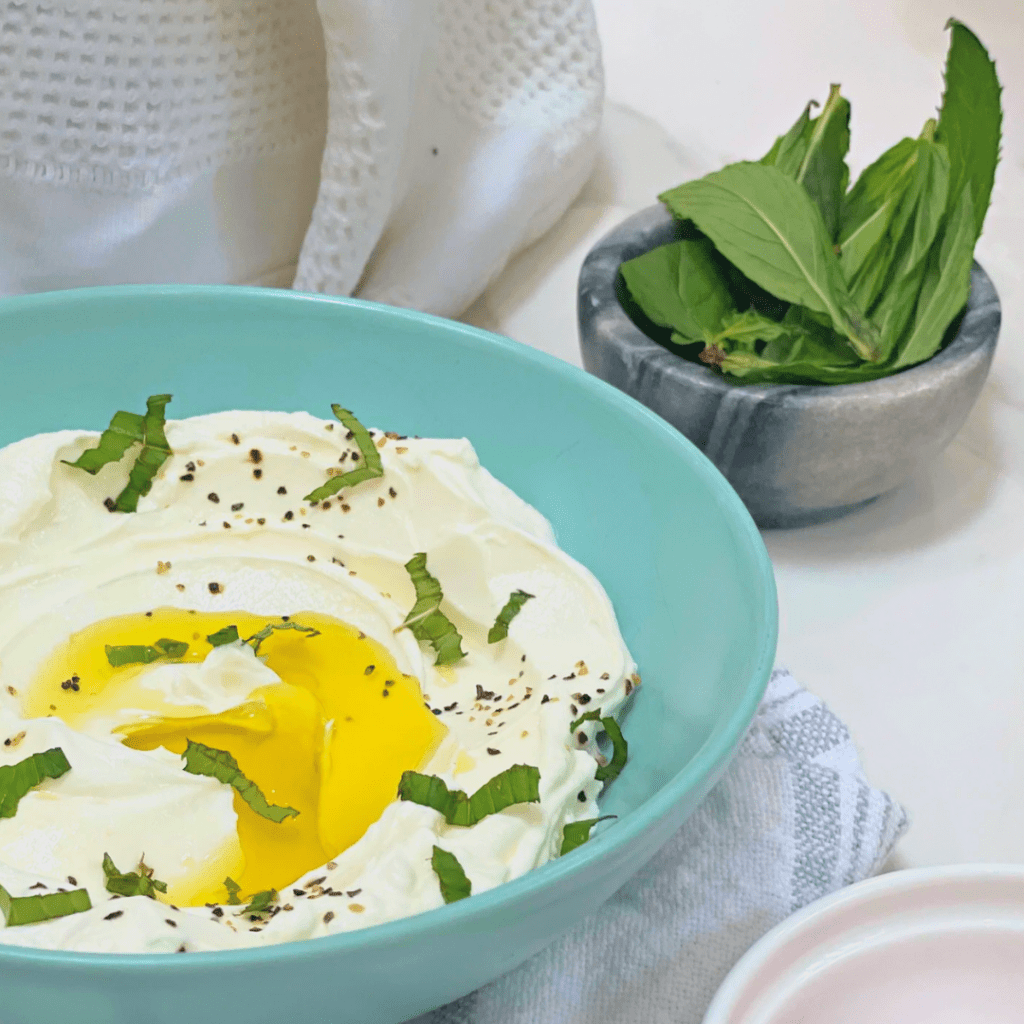
This recipe is the easiest thing you’ll make, ever! It has very few ingredients and minimal steps! Plus you can make it ahead of time and keep it in the fridge for at least a week for fast, nutritious snacks and lunches.

Labneh
Equipment
- 1 mixing bowl
- 1 large bowl
- 1 strainer
- 1 large cheesecloth or kitchen towel
Ingredients
- 1 container full fat yogurt (750g)
- ¾ tsp salt (optional)
Instructions
- Add the entire container of yogurt to a bowl.
- Add salt and mix.
- Line a strainer with a thick cheese cloth or kitchen towel.
- Place a strainer on top of a separate empty large bowl and add the yogurt mixture into the cloth, folding it over to cover the mixture.
- Let the mixture set for 24-48 hours in the fridge (the longer it sits, the thicker it will be).
- Drizzle with olive oil and choice of seasonings, and enjoy as a dip or spread!
Notes
If you’re feeling stressed about starting solids and you’re not sure where to begin, join our FREE live workshop – How to start solids: A realistic first week of feeding your baby. This workshop is for parents ready to feel confident and prepared to start solids—without all the guesswork.
Learn exactly what to feed, when to feed it, and how to do it—step-by-step—with expert guidance from pediatric dietitian, Edwena Kennedy. Plus, get a free 5 day meal plan just for attending!
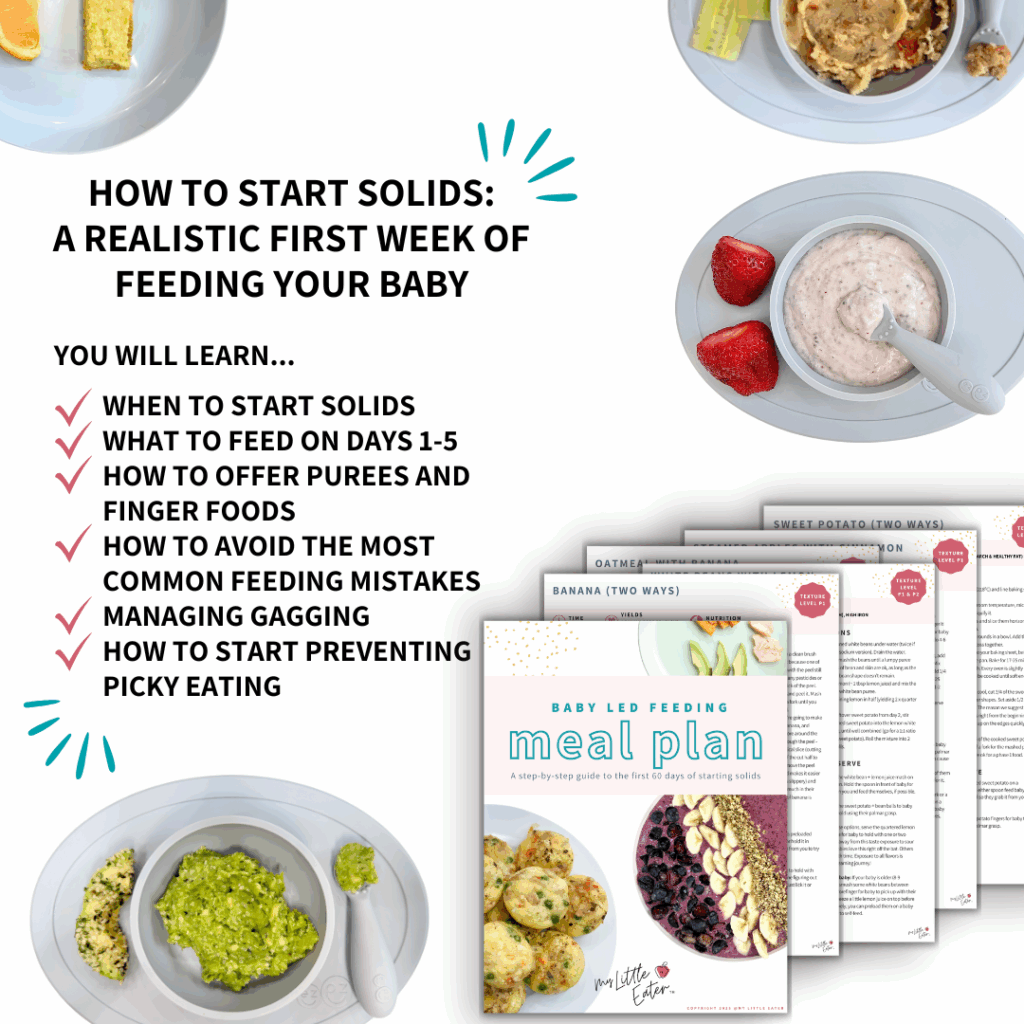
Love it? Pin it to save for later!
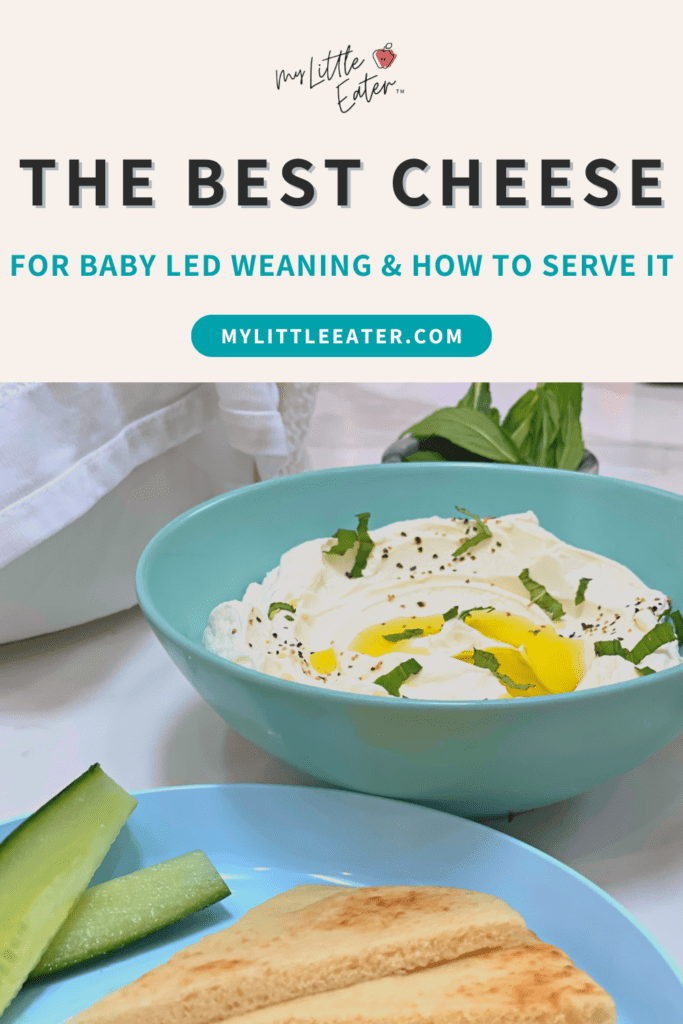
References
Food Allergy Canada. Early Introduction. 2019. Retrieved from https://foodallergycanada.ca/living-with-allergies/ongoing-allergy-management/parents-and-caregivers/early-introduction/
Canadian Paediatric Society. Introduce complementary foods earlier to prevent allergy: paediatricians. Jan 24, 2019. Retrieved from: https://cps.ca/en/media/introduce-complementary-foods-earlier-to-prevent-allergy-paediatricians
https://www.niddk.nih.gov/health-information/digestive-diseases/lactose-intolerance/symptoms-causes
https://www.foodallergy.org/resources/milk-allergy-vs-lactose-intolerance
InformedHealth.org [Internet]. Cologne, Germany: Institute for Quality and Efficiency in Health Care (IQWiG); 2006-. Lactose intolerance: Learn More – What can lactose-intolerant people eat? [Updated 2022 Jan 25]. Available from: https://www.ncbi.nlm.nih.gov/books/NBK534631/
Panseri, S.; Pavlovic, R.; Castrica, M.; Nobile, M.; Di Cesare, F.; Chiesa, L.M. Determination of Carbohydrates in Lactose-Free
Dairy Products to Support Food Labelling. Foods 2021, 10, 1219
Heyman, M. B., & Committee on Nutrition. Lactose intolerance in infants, children, and adolescents. Pediatrics, 118(3), 1279-1286 (2006).
Dekker PJT, Koenders D, Bruins MJ. Lactose-Free Dairy Products: Market Developments, Production, Nutrition and Health Benefits. Nutrients. 2019 Mar 5;11(3):551. doi: 10.3390/nu11030551. PMID: 30841534; PMCID: PMC6471712.
McCarthy, A. L., O’Connor, T. P., & O’Brien, N. M. Cheese in the context of diet and nutrition. In Handbook of cheese in health: Production, nutrition and medical sciences (pp. 5-8). Wageningen Academic Publishers (2013).
Schwendel, B. H., Wester, T. J., Morel, P. C. H., Tavendale, M. H., Deadman, C., Shadbolt, N. M., & Otter, D. E. Invited review: Organic and conventionally produced milk—An evaluation of factors influencing milk composition. Journal of dairy science, 98(2), 721 (2015).
Orjales, M. Lopez-Alonso, M. Miranda, H. Alaiz-Moretón, C. Resch, S. López. Dairy cow nutrition in organic farming systems. Comparison with the conventional system, Animal, Volume 13, Issue 5, 2019, 1084-1093,ISSN 1751-7311
Committee on Infectious Diseases, Committee on Nutrition, Brady, M. T., Byington, C. L., Davies, H. D., Edwards, K. M., … & Schwarzenberg, S. J. Consumption of raw or unpasteurized milk and milk products by pregnant women and children. Pediatrics, 133(1), 175-179 (2014).
Choi, K. H., Lee, H., Lee, S., Kim, S., & Yoon, Y. Cheese microbial risk assessments-a review. Asian-Australasian journal of animal sciences, 29(3), 307-314 (2016).
United States Department of Agriculture. Infant Nutrition and Feeding. Retrieved from: https://wicworks.fns.usda.gov/sites/default/files/media/document/infant-feeding-guide.pdf
Lönnerdal, B. Calcium and iron absorption—mechanisms and public health relevance. International Journal for Vitamin and Nutrition Research, 80(4), 293 (2010).

Chelsey Landry, RD
Community Dietitian at My Little Eater Inc., and bunny-mom to Hickory. Chelsey offers one-on-one counselling to parents of babies and toddlers that need more customized support. Learn more by booking a free discovery call with her today!

Chelsey Landry, RD
Community Dietitian at My Little Eater Inc., and bunny-mom to Hickory. Chelsey offers one-on-one counselling to parents of babies and toddlers that need more customized support. Learn more by booking a free discovery call with her today!
